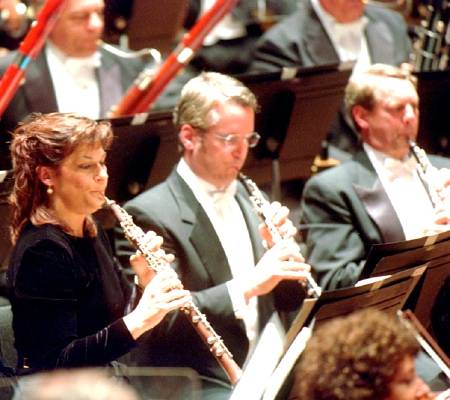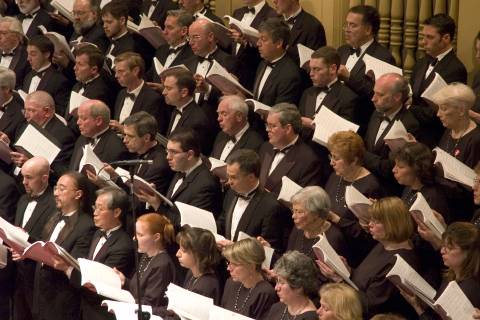|
<< -- 4 -- Kelly Ferjutz A SPECIAL PERFORMANCE

Mr Frühbeck de Burgos conducted the entire program without a score, and was obviously familiar with all the nuances required by the choral pieces, which he treated as a three-part entity. Nänie (with text by Schiller) featured a perfectly ravishing oboe solo by Cynthia DeAlmeida, and periods of a capella singing by the chorus. It is by nature a very peaceful work, made more so by the transparent sound of the choir.

PSO Oboes. Photo: Pittsburgh Symphony Orchestra
|
Gesang der Parzen (set to Goethe) began in an agitated, almost strident fashion, somewhat of a shock after the serene Nänie. This work is a musical picture of turmoil, or song of the fates. The orchestral brass in a chorale near the end had me searching the Hall for the non-existent organ. Again the choir distinguished itself with marvelous attention to detail.
Song of destiny -- Schicksalslied, set to a poem by Holderlin, was composed some ten years earlier than the other two pieces, but together, they formed a nearly seamless work. It begins with an orchestral introduction in a minor key, shifting to major for the conclusion, led by broad sweeping gestures from the conductor. In a subtle nod to the earlier composer, Beethoven's four-note 'fate' motif echoes softly on the timpani throughout the piece. Throughout, the choir was especially responsive to the conductor's every command, immediately reducing or increasing volume, as he indicated.

Members of the Mendelssohn Choir of Pittsburgh
|
Everyone involved -- both conductors, orchestra and choir -- received a warm and well-deserved ovation from the large audience. My only very slight quibble was that unlike at Severance Hall, the house lights were dimmed too low to enable one to follow the text in the program book. Of course, this does also keep the rustle of turning pages at a minimum during the music. On the other hand, this orchestra does one action on a regular basis that I like very much. At the end of a piece, when they stand to accept the applause of the audience, they turn and face that audience directly. It's a very nice touch, I think -- a reaching out to the audience -- and I wish more orchestras would do the same, considering that based on the usual seating protocol, the strings generally face each other! How neat to look at the audience for a change.
I'm not usually a seat-hopper, and although I did enjoy the sight-lines and the sound factor where I was seated in the Family Circle (lower portion of upper level) for the first half of the concert, I did notice a few empty seats in the very upper part of this level, so I indulged myself by moving upwards for the Beethoven. Fortunately, I had my binoculars (it's a long way to the stage from up there!) and could thus just revel in the lush, magnificent sound.
Continue >>
Copyright © 7 November 2006
Kelly Ferjutz, Cleveland USA

|

